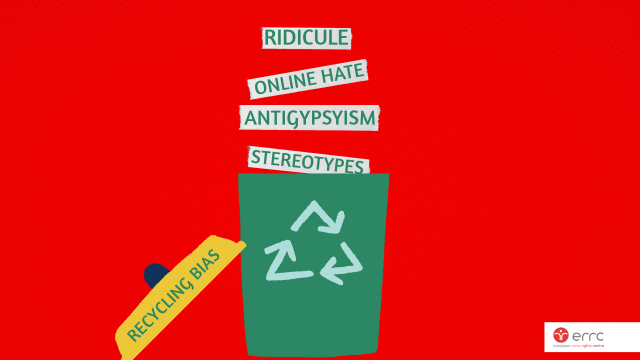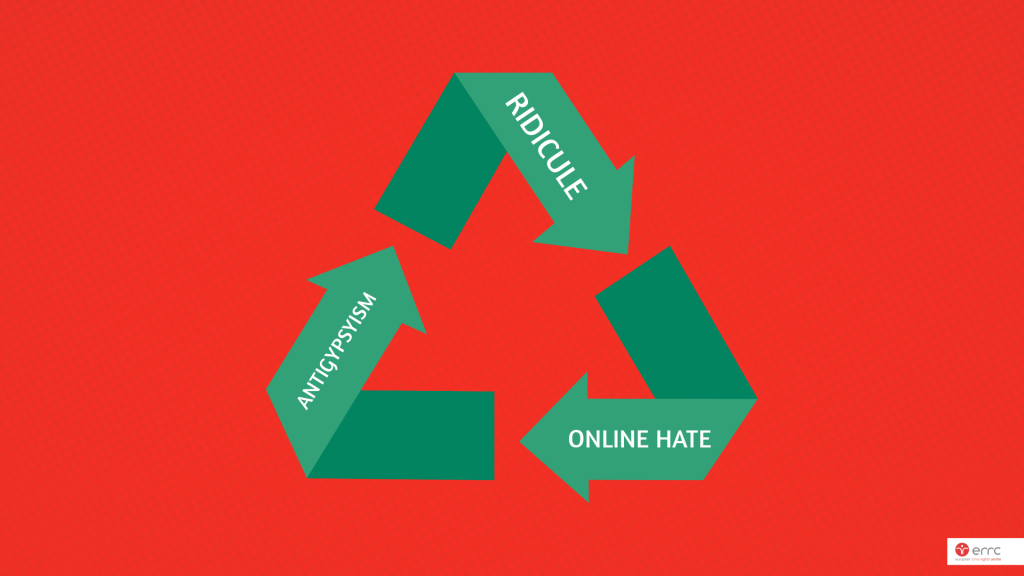Do Roma have the right to be more than clickbait?
12 September 2024

By Barbora Bešenejová
Social marginalisation, mass surveillance, message control - you name it, social media is contributing to it. A compelling amount of evidence shows how social media companies' infrastructure and inconsistent enforcement of policies have limited user agency, especially regarding the voices of marginalised communities and underrepresented groups.
Although the expanding global spaces for expression provided by social media sites have, in some ways, amplified the diversity of voices, they have also dramatically accelerated a trend for ‘clickbait’ narratives. Easily shared and circulated, such online content has a strong impact on defining users' public image. This is made all the more so by recommender algorithms driving what type of content gets prioritised and/or censored on our social media feeds. Rather than accurate or relevant content, stereotypical portrayals - often laced with hate speech - often gain more traction and engagement.
For Roma, this online environment that thrives on clicks is set alongside a broader context where antigypsyism is historically entrenched and widely accepted, with little recognition or understanding of the specific dimensions and manifestations of the structural racism Roma endure. This raises substantial human rights concerns regarding what consequences this has and can hold, not only for the groups that are disproportionally affected but also for society at large.
During the last two years, through the volunteer-led Challenging Digital Antigypsyism project, the ERRC brought together young Roma rights defenders from different countries and backgrounds to challenge how offline bias towards Roma is reproduced or, rather, obscured in online spaces.
The perfect breeding ground for hate to accumulate online, as the volunteers came to see, was often (if not most often) found under content that was not explicitly racist. In fact, the content which most easily distracts the masses into apathy, ridicule, and hate is often subtle, and often presented as comedic. Emotionally-charged and exaggerated visual representations are the go-to portraits of Roma being recommended online, inspiring comment sections to be filled with a plethora of hate. Such viral images are frequently recycled from various reporting media outlets that commonly and intentionally trade on stereotypes about Roma while providing media coverage from local news events. In the process of filming eyewitness accounts or reaction videos, they take advantage of the low level of education and the lack of media awareness of some marginalised Romani communities.
A prime example of this in Slovakia is the “tu kabel” news reportage. This was an interview shot with a Romani woman, Helena from Rudňany, about her community’s lack of access to legal sources of electricity. Helena gained unforeseen fame due to her gesticulating and repeating the phrase “tu kabel” (here’s the cable) during the interview. Besides “tu kabel” becoming a well-known colloquial phrase, Helena’s interview has been songified into funny remixes; or it has become the subject of photomontages and merchandise. Her material circumstances, though, have remained unchanged.
In a follow-up interview for TV JOJ, Helena explained that she is now ashamed to walk down the streets: "It's not good anymore; enough of the fun. They made a fool of me". Video remixes stripped her of her agency as she attempted to protect her community and obscured the issue at the heart of the interview: that being forced to depend on unsafe electricity connections was endangering Helena’s life and the life of her community. Sadly, that is not the story that caught the media or the public’s attention.
The recently popular site Myšlienky Slovákov (What Slovaks Think) has also taken advantage of playing on society’s most racist sensibilities. With 147 followers just on Instagram (as of August 2024), the site reposts reels of interviewees that have become viral over time. Unsurprisingly, in a large number of the posted videos the main ‘stars’ of this site are Roma. Moreover, these ‘funny’ reels provide space for a tsunami of harassment and hateful comments that interlock with different target groups and forms of oppression, such as racism, sexism, ageism, ableism, homophobia, and fatphobia, sometimes even targeted at children. Many of the reels are compiled from a TV show (that ran for around 15 years) in which presenters on the streets targeted pedestrians who may, at first glance, look mentally ill, belong to minority groups, are intoxicated, or are houseless. By asking them nonsensical questions, they opted to measure ‘the level of national intellect’.
This trend is not confined just to Slovakia; content like this can be found across Europe. What this clickbait shows is how this type of online discourse is both new and unique to the Internet but contains age-old patterns that continue to resonate both offline and online. Despite widespread condemnation, the minstrel premise still prevails in entertainment, film and music industry, or in its current most advanced iteration, on the Internet. In Albania, various clips, voice-overs, and lip-syncs online that perpetuate harmful stereotypes are recycled from a comedy programme, broadcast on national TV, that used blackface to imitate Roma.
Some have used the term ‘digital blackface’ to describe how racial stereotypes are often mimicked and appropriated online through ‘humorous’ memes, GIFs, TikToks, Instagram reels, and so on, while structural inequalities associated with education, material deprivation, the labour market, and discrimination are presented as entertainment without recognising them as human rights issues. As Janell Hobson puts it; "representations of digital technology recreate social and cultural hierarchies that encourage the appropriation and colonisation of knowledge and bodies from marginal communities."

In the black box of the internet
It is difficult, however, to comprehend the exact extent or consequences of hate speech online due to the ‘black box’ nature of the online platforms; the non-transparent algorithms of social media sites may amplify biased content, but the inner workings are obfuscated. Research scrutiny coming from the European Commission and its partners goes some way to addressing this by annually evaluating the implementation of the Code of Conduct on countering illegal hate speech online. According to their hate monitoring exercises, antigypsyism is among the most commonly reported grounds of hate. The results also indicate a downward trend in reviewing notifications related to illegal hate speech on social media platforms. The latest FRA research shows that, as a group, Roma experience the second highest levels of online abuse and harassment, with misogyny taking the top spot as the most prevalent form of online hate across all the platforms the research covers.
But hatred online has consequences beyond the virtual world. Moderate behaviours and abuse, especially cumulatively over time, are just as capable of causing harm to targets as overtly hateful actions. Another survey by FRA shows that Romani respondents and respondents with sub-Saharan or north-African backgrounds experience higher rates of real-world discrimination, harassment, and violence motivated by hatred. Because of the underreporting and under-recording of incidents and incomparable data collection methods, however, these figures only represent the tip of the iceberg. Sources show that 88% of hate-motivated physical attacks against Romani people were not reported. These high levels of abuse demonstrate the dehumanising nature of online abuse, which erodes not only Romani people's fundamental rights and freedoms of speech and self-expression but also society at large. Its prevalence also points to a significant lack of investment and expertise in preventing and moderating hate against these groups. The experiences and knowledge of historically marginalised communities like Roma, however, have been conspicuously absent from European policy discussions and decisions on artificial intelligence, as the Equinox Racial Justice Initiative has pointed out.
Mitigating hatred
With the aim of promoting responsibility and accountability, the EU wants to impose strict algorithmic transparency requirements on AI-based systems and platforms. Under the EU's new Digital Services Act (DSA), and EU Artificial Intelligence Act, major tech platforms are now compelled to combat online hate speech, illegal content, and disinformation. The proposed changes could increase oversight for recommender systems on social media platforms and potentially increase tech companies' liability for the impact of user-generated content.
According to some, the implementation of fair, accountable, and transparent machine learning requirements will hinder biased, racist, or sexist automated systems. However, while essential, these technical methods of mitigating hatred appear to fall short of guaranteeing ‘bias-free effects’. This is because technology exists alongside, rather than at the heart of, a biased and unjust society. According to EDRI's report, debiasing initiatives entitle service providers to adjudicate discrimination, human rights abuses, and unfairness at their own discretion, thereby consolidating and centralising additional leverage to these big actors.
If we are ever to break away from recycling biases, mainstreaming racial equality considerations into digital policy should be of pivotal focus. Unless algorithms, or the social media systems into which they are integrated, explicitly account for the legacy of continuous structures of inequality and bias aligned to racial difference, fundamental rights protection for racialised communities will remain limited. Tech experts, companies, policymakers and various institutional structures can and should address the enormous disparity between social cost and private gain that blocks Romani communities in their digital emancipation; their right to be more than easy clickbait.
This article was written by one of our Roma Rights Defenders as part of the ‘ERRC Newsroom’ project, bringing together Romani and non-Romani activists with an interest in journalism and human rights. The project provides volunteers with mentoring, copy-editing, training, and opportunities to pitch articles on Roma Rights issues for publication on ERRC News. If you are interested in pitching an article to ERRC News, or joining this volunteer project, send an email to news@errc.org.




